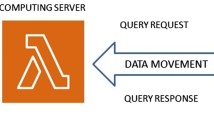Abstract
Although cloud computing has made significant achievement, it still faces many challenges, such as bad interactive performance and unsatisfying user experience over a long-haul wide-area or wireless network. To address these challenges, we proposed a software-defined stream-based code scheduling framework according to the concept of transparent computing. This framework uses the idea of code streaming to decouple the computation and storage of software codes; this idea also leverages the input/output virtualization technique to support legacy operating systems and application software in a feasible and effective way. The software-defined code scheduling framework allows the computation or storage to be adaptively carried out at appropriate machines with the assistance of performance and capacity monitoring facilities. Thus, the framework can improve application performance and user experiences by executing software codes on a nearer or better machine. We developed a pilot system to investigate the advantages of the proposed framework. Preliminary experimental results show that our approach can achieve better performance than current cloud computing-based systems.







Similar content being viewed by others
Notes
Note that there are different approaches to migrating the computation and storage of a computing task. In this paper, we use the virtual machine technology to encapsulated a computing task as a virtual appliance or virtual desktop [12, 13] in cloud computing and thus use the virtual machine migration technique to migrate a computing task.
References
Satyanarayanan M, Bahl P, Cáceres R, Davies N (2009) The case for VM-based cloudlets in mobile computing. IEEE Pervasive Comput 8(4):14–23
Atwood C A, Goebbert R C, Calahan J A, Hromadka T V, Proue T M, Monceaux W, Hirata J (2016) Secure Web-Based access for productive supercomputing. Comput Sci Eng 13(1):63–72
Flores H, Hui P, Tarkoma S, Li Y, Srirama S, Buyya R (2015) Mobile code offloading: From concept to practice and beyond. IEEE Commun Mag 53(3):80–88
Tolia N., Andersen D., Satyanarayanan M. (2006) Quantifying interactive experience on thin clients. Computer 39(3):46–52
Williamson A (2010) Has Amazon EC2 become over subscribed? http://alan.blog-city.com/has_amazon_ec2_become_over_subscribed.htm
Iosup A, Ostermann S, Yigitbasi N, Prodan R, Fahringer T, Epema D (2011) Performance analysis of cloud computing services for many-tasks scientific computing. IEEE Trans Parallel Distrib Syst 22(6):931–945
Zhang Y, Zhou Y (2006) Transparent Computing: A New Paradigm for Pervasive Computing Proceedings of the 3rd International Conference on Ubiquitous Intelligence and Computing (UIC06), pp 1–11
Zhang Y, Zhou Y (2013) Transparent computing: spatio-temporal extension on Von Neumann architecture for cloud services. Tsinghua Sci Technol 18(1):10–21
Hayes B (2008) Cloud computing. Commun ACM 51(7):9–11
Bonomi F, Milito R, Zhu J, Addepalli S (2012) Fog computing and its role in the internet of things Proceedings of the first edition of the MCC workshop on mobile cloud computing (MCC ’12). Helsinki, Finland, pp 13–16
Drolia U, Martins RS, Tan J, Narasimhan P (2013) The case for mobile edge-clouds Proceedings of IEEE 10th International Conference on Ubiquitous Intelligence and Computing, pp 209–215
Xen Desktop (2016). https://www.citrix.com/products/xendesktop/overview.html
VMware Horizon (2016). http://www.vmware.com/products/horizon-view/
Salesforce platform (2016). http://www.salesforce.com
Google Docs (2016). https://docs.google.com/
Microsoft OneDrive (2016). https://onedrive.live.com/
Richardson T, Stafford-Fraser Q, Wood K R, Hopper A (1998) Virtual network computing. IEEE Internet Comput 2(1):33– 38
Satran J, Meth C S K, Chadalapaka M, Zeidner E (2004) Internet Small Computer Systems Interface (iSCSI). RFC:3720
Zimmer V, Rothman M, Hale R (2006). Implementing the Unified Extensible Firmware Interface with Intel’s Framework. Intel Press, ISBN: 0-9743649-0-8, Beyond BIOS
PassMark Performance Test (2016). http://passmark.com/products/pt.htm
Nieh J, Yang S J, Novik N (2001) Measuring thin-client performance using slow-motion benchmarking. ACM T Comput Syst 21(1):87–115
Gmail (2016). https://www.gmail.com/
Miluzzo E, Cáceres R, Chen Y (2012) Vision: mClouds - computing on clouds of mobile devices Proceedings of the 3rd ACM workshop on Mobile cloud computing and services (MCS ’12), pp 9–14
Li H, Shou G, Hu Y, Guo Z (2016) Mobile Edge Computing: Progress and Challenges Proceedings of the 4th IEEE International Conference on Mobile Cloud Computing, Services, and Engineering (MobileCloud), pp 83–84
Yi S, Li C, Li Q (2015) A Survey of Fog Computing: Concepts, Applications and Issues Proceedings of the 2015 Workshop on Mobile Big Data (Mobidata ’15), pp 37–42
Cumberland B, Carius G, Muir A (1999) Microsoft windows NT server 4.0 terminal server edition. Microsoft Press, Technical Reference
Boca Research I (1999) Citrix ICA technology brief. Technical White Paper, Boca Raton
SPICE Project (2016). http://www.spice-space.org/
Baratto RA, Potter S, Su G, Nieh J (2004) MobiDesk: mobile virtual desktop computing Proceedings of 2004 International Conference on Mobile Computing and Networking, pp 1–15
Satyanarayanan M, Gilbert B, Toups M, Tolia N, Surie A, O’Hallaron D R, et al. (2007) Pervasive personal computing in an internet suspend/resume system. IEEE Internet Comput 11(2):16–25
Satyanarayanan M (2002) The evolution of coda. ACM T Comput Syst 20(2):85–124
VMware workstation (2016). http://www.vmware.com/products/workstation/
Cáceres R, Carter C, Narayanaswami C, Raghunath M (2005) Reincarnating PCs with portable SoulPads Proceedings ACM/USENIX MobiSys, pp 65–78
Chandra R, Zeldovich N, Sapuntzakis C, Lam MS (2005) The collective: a cache-based systems management architecture Proceedings of NSDI, pp 259–272
Acknowledgments
This work is supported by the Tsinghua University Initiative Scientific Research Program (Grant No.: 20161080066) and the International Science & Technology Cooperation Program of China (Grant No.: 2013DFB10070).
Author information
Authors and Affiliations
Corresponding authors
Additional information
This article is part of the Topical Collection: Special Issue on Transparent Computing
Guest Editors: Jiannong Cao, Jingde Cheng, Jianhua Ma, and Ju Ren
Rights and permissions
About this article
Cite this article
Zhou, Y., Tang, W., Zhang, D. et al. A case for software-defined code scheduling based on transparent computing. Peer-to-Peer Netw. Appl. 11, 668–678 (2018). https://doi.org/10.1007/s12083-017-0552-x
Received:
Accepted:
Published:
Issue Date:
DOI: https://doi.org/10.1007/s12083-017-0552-x




